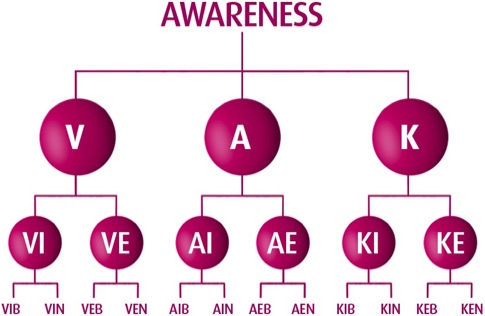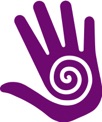
Just give us call or send us an email at: simon@hawkeen.com
We attend to the world with our senses - vision (V), hearing or auditory (A) and feeling or kinesthetic (K) being the dominant modes. This VAK scheme is just shorthand for talking about our major senses. People often consider their thoughts as separate from the senses, but it's important and central to Hawkeen Training to realise that thoughts are represented in sensory (VAK) modes. From a sensory point-of-view, a separate class of brain sensations called 'thoughts' doesn't exist. What we consider thoughts are merely sensory representations. We can be aware of these structures (or thoughts) through a process called “going Meta”, where the object of our awareness is our thoughts and thought processes, the processing of sensory information.
If you were now to remember or imagine anything (have a thought) you can become aware that you are using some combination of seeing, hearing or feeling (VAK) to HAVE the thought. Often the content of the thought overshadows the fact that the thought structure itself is sensory. Usually the content of the thought is more important to us than its structure. But the fact of this sensory structure is what gives Hawkeen Training most of its power.
Ignoring the sensations of taste and smell, as smell and taste are far less prominent in the thought structure of most people, sensory information means VAK. Most people are aware and conversant with the components of the VAK scheme. Which is to say that most people know what you mean when you speak of seeing, hearing and feeling. But the Hawkeen have discovered two additional components which add invaluably to the 'structure' of thoughts and, as such, the VAK model is an under-generalisation of the extent of our sensory abilities by a factor of 4. In fact, these two additional components seem to be the central drivers in physiology. We can and do make two other sensory distinctions, broad/narrow and internal/external, as explained in the following excerpt from
The Structure of Delight pp. 97-98
Noom chuckled. “Knowing that your attention is always somewhere is the first step to gaining mastery of perception. We can perceive the world using all three senses simultaneously. When you waded the river you could feel and hear and see the water at the same time, making your experience much richer. You can start learning attention by noticing where it is at a particular moment. After you have gotten fairly good at noticing where your attention is, and in what mode, then you can begin to switch. For instance, when you hold a rock do you get most of your information concerning the rock from feeling it? Or do you get it from seeing the rock or hearing any sound it makes as you turn it in your hand? Whatever your favourite sense for rocks is, try the other two. Shift your attention to the others and find out what they're like. The next step is to change consciously the width of your attention. As you look at the landscape, expand your vision as far to the sides and up and down as you can. Then narrow your vision to one particular point and notice the difference. Try the same with hearing and feeling. Wide and narrow, notice the difference. After you've practiced for a time you'll notice that paradoxically the extremes seem somewhat similar. Very narrow and very wide have a strange relationship to each other. They meet on the other side."
"The other side of what?" Jay asked.
"I don't really know," Noom shrugged. "Like I say, it's a paradox."
"There certainly seem to be a lot of paradoxes."
"Well, I'm certain of how it works but not why. Don't let the existence of paradoxes stump you. A paradox is just another way of saying that you haven't figured it out yet. Anyway, you'll find that switching attention from internal to external involves something of a jump, but wide and narrow seem separated only by degree. They're not really, but it seems that way." Noom paused, marvelling at the strangeness of the idea. "In any event, one state isn't better than other any state. However, one may be more useful in a given situation. With three senses and four modes that makes an even dozen ways to perceive. The Hawkeen call this the Twelve States of Attention."
"And they sit around and practice this stuff?"
"Some practice until it becomes automatic and then they forget about it; others play with it their entire lives. They say it adds sparkle to the world. When you were in school you occasionally heard a teacher say, 'You're not paying attention.' The fact was that you were paying attention but not in the way your teacher wanted. When someone says 'Pay attention,' they usually want you to focus your attention externally. Some tasks require several of the twelve states in combination. To gain mastery you must train yourself to stay in any single state for long periods. When you can do that then practice rapidly switching through all twelve. It's not a matter of will but a matter of training. The practice of meditation, for instance, is the training of attention in a very specific way, usually internal and narrow. If you set out to learn to meditate you will be amazed at how quickly and easily attention can move to other states. So the primary training meditation provides is the ability to hold attention in a single state for long periods.
"That's not so hard. Why do you make it sound like such a big deal?" Jay countered.
"Very well then." Noom opened his eyes widely before issuing his challenge. "Look at your thumb nail for one minute. Find out what happens to your attention."
"Just look at my thumb nail for a minute?"
"Yes. You said 'just'. Find out how big 'just' is. Can you direct your attention for a single minute?"
Jay positioned his legs under him placing a hand in his lap. Closing his fingers with his thumb on top, he began to peer at his nail. Noom watched as every few seconds a slight contraction in Jay's brow indicated he had caught his attention wandering. Seconds ticked on.
"That's long enough. Now tell me how big 'just' is."
"Bigger than I thought," said Jay sheepishly. "So how can I keep attention on my thumb?"
Our brains have distinct and separate neurological structures for processing what can be called broad and narrow sensations. It isn't a matter of degree, it's a matter of which parts of our brains we use for a particular activity. For example, the eye contains two types of light receptors: rods and cones. We use cones for narrow focused vision and rods for broad peripheral vision. Information from these two types of visual receptors is processed independently and in different areas of the brain. They are fundamentally different classes of perceptions thus different types of thought. Again, it's not a matter of degree but of a fundamental difference. Cameras focus and zoom , but this really isn't the same as the eye's broad and narrow ability. The camera is changing by degree, not shifting perception. For those with an uncontrolled interest in such technical matters the May 1991 issue of Scientific American contains an article on an optical device which can, in fact, shift from focused to peripheral vision.
Hearing also is split into broad and narrow, differences which can be noticed in what's called the “Cocktail Party Effect”. At a party we can focus our attention on the sound of a single voice or switch to hearing the entire room. Those of you who have attempted to record someone in a noisy setting know the result of this phenomena. Electronic manufacturers have attempted to design a device which has the capability of recording a single voice separate from a noisy background, but to no avail. At present we don't have any idea how to get a machine to narrow its auditory focus, something that we all do everyday without conscious effort.
Our skin serves as the boundary for distinctions of internal and external. What we feel on the outer surface is considered external and what we feel inside our skin boundary is internal. Likewise what we remember or imagine visually or auditorily is internal, what we see or hear external to our eyes and ears is external. Those interested in the concept and experience of THE NOW should limit themselves to external awareness, which is by definition NOW. And it should also be apparent that when we are thinking of the past or future (not NOW) these thoughts can be generated only with internal states of attention. Usually, pain is experienced as a narrow perception; we know right where it hurts. Pleasure, general well being and relaxation, on the other hand, tend to be very broad diffuse sensations. We find the question, “Where, exactly, do you feel wonderful?” somewhat odd because wonderful is a broad sensation. A substantial amount of relief from pain can be achieved simply by shifting from KIN (Kinesthetic Internal Narrow) to KIB (Kinesthetic Internal Broad). Those who aren't proficient at KIB don't experience a lot of pleasure or satisfaction as they lack the sensory basis or capacity for such feelings. The whole experience of happiness rests directly on two of the twelve states, KIN and KIB.
The illustration below is generalised by having 'X' stand for either V, A or K. So unhappiness is experienced as XIN or the Water state and happiness is the direct result of being in the Air quadrant - XIB. What we're saying is that the experience of happiness (or any other emotion) is much more a result of the quadrant from which it is experienced than anything else.
The 12 States of Attention
“Knowing that your attention is always somewhere is the first step to gaining mastery of perception”
Noom, the principle character in The Structure of Delight by Nelson Zink
These two additional sensory distinctions (internal-external [I-E] and broad-narrow [B-N]) are probably more important to our functioning than either vision, hearing and feeling by itself. Without an internal-external distinction we would have no concept of time or space. As young children develop their I-E ability they become proficient at understanding time and distance (how long till their birthday and how far to grandmother's house). The whole notion of “weak boundaries” is just another way of talking about weak I-E abilities. Broad-narrow is, to some degree, lost in our culture. And those who practice it are generally considered (in the Western world) simpletons. They aren't “paying attention”, they never “focus on anything”, but this single distinction probably has more to do with the experience of wisdom (XXB) than any other sensory distinction, the ability to “step back a bit and see the big picture, hear the cosmic symphony, feel the big connection”.
We're suggesting that these two distinctions are so important that they should be considered at least on the same level as sensory modalities. If we were to think of major modalities as numbering five instead of three, then VAK should read VAK(I/E)(B/N).
Each of us usually have a group of favorite attention states within the twelve. Take a few minutes and systematically enter all twelve (see the first illustration). Access each of the states (think some thought which is possible only in that state) and find and identify your favorites, the ones easiest for you. Notice which states are hardest to achieve and sustain. If you're interested in developing your sensory skills, hence your overall mental ability, then designing a personal training program is made much easier by knowing which of the twelve states are your weakest. Practice is, of course, the path to proficiency.
Exercise #1
1. VIB Imagine or remember an impressive vista...a sunset for example. The widest trailer you've ever seen. 10,000 marching abreast.
2. VIN Imagine or remember looking at the very tip of your pencil when you write. The point where the highway vanishes into the distance.
3. VEB See as much as you can of the room you're now in without moving your gaze. Both to the sides and up and down. How far in each direction?
4. VEN Pick the smallest thing (1/4" or less) you can now see (within a few feet) and examine it carefully. Rough, shiny, smooth, pointed?
5. AIB Imagine or remember the sound of roomful of noisy people. Listen to 100 geese--the goose choir. A stadium during a game.
6. AIN Imagine or remember the first violin in a piece of music. The squeak from a door. A mouse scurrying.
7. AEB What's the total sound of your present environment? All the sounds. Is there a motor running? A fan? Crickets?
8. AEN Pick just one of those sounds and listen intently to its character. What's it character? Then a different sound.
9. KIB How's your general physical well being--head to toe? Feel warm, cold, full, tired? Feel your heartbeat---then in your fingers and feet.
10. KIN What's the sensation in your right big toe? Your left knee. Right ear. Different than left? Which is warmer, your right or left hand?
11. KEB How tightly are your clothes fitting at the moment? Remember jumping into cold water. The heat of the Sahara.
12. KEN What is the air movement on the back of your right hand? The fit of your right shoe. Which elbow is experiencing the greater pressure?
Each of these examples is just to give you the general idea. Generate your own. Experience a state for 5 seconds. Make an assessment and record the ease of experience. Move to the next state. Review assessments and search for a pattern. Do you tend to hear things more readily than see them...etc.? Which type sensory experience is easier? More difficult? Now you know what to work on. Run through the 12 States each day, giving particular attention to the difficult ones. Do it backwards when it gets boring. Rearrange the list in any order you want, but make sure to include all states.
Exercise #2
Take a single event and experience it in each of the 12 states (or as many as is pertinent). The point being to notice the perceptual differences inherently contained in each state of attention. Is seeing different from hearing, feeling...etc.? Notice in particular the broad and narrow aspects of your experience
Those we call “Associators” have difficulty with internal-external distinctions. For them most sensation is perceived as being internal and as such, fully one-half of the normal range of awareness is unavailable. If someone else hits their thumb with a hammer do you flinch? If so why? What state of attention must be used to do this?
Likewise, those who habitually “fixate” are typically unaware of broad-narrow distinctions and miss out on another half of the world. Do you typically see the forest or the trees? Only when we have developed and use our full range of sensory skills can we appreciate the complete extent of human experience. Or to say it another way, until we actively use all Twelve States of Attention regularly, we remain less than human. The “Human Potential Movement” speaks of “full” potential, something which is attainable only with full sensory awareness, all twelve states. For example, learning to relax requires a good ability at broad-narrow distinctions. It should become obvious that “problems” or “difficulties”, by definition, involve the inappropriate use of one or more of the twelve states of awareness. Our vicissitudes can usually be traced to some personal sensory limitation.
What to do? Well, it's a matter of becoming aware of all the Twelve States of Attention and exploring each until it becomes familiar, then automatic. As this ability grows, one learns to identify easily any particular state of attention in oneself and/or others. When we have a choice of the states of attention to be used during any task living becomes much easier. Mastery of our moods and capabilities begins with mastery of attention. If we're not using our full deck we always come up short at some point.
With the Physiology Map we made the connection between physiology and emotion. With States of Attention we're making the connection between attention and physiology. Now we have a direct connection between attention and emotion--shift attention and emotion follows.
At its core, Hawkeen Training is based on and makes use of this interconnection. You've probably heard the aphorism, 'You are what you think.', we want to change it a little - You are HOW you think!
Your task is to experience all 12 States of Attention.
Use the form above (Exercise #1) and become aware of which states are easy and which aren't. From this you can begin (referring to The Physiology Map above) to make some conjectures about how your sensory abilities and inabilities impact your experience.
After directing your attention through all 12 states practice (Exercise #2).
Practice and strengthen your weaker sensory areas as they constitute perceptual and experiential holes in you life!
At 5 seconds a shot it'll take just one minute to run through the Twelve States of Attention. Practice that Minute a few times a day--it's the gateway to your full potential. Nelson Zink http://www.navaching.com


XEN
XEB
FIRE
EARTH
XIN
XIB
WATER
AIR
EXTERNAL
INTERNAL
NARROW
BROAD
07887 811567
